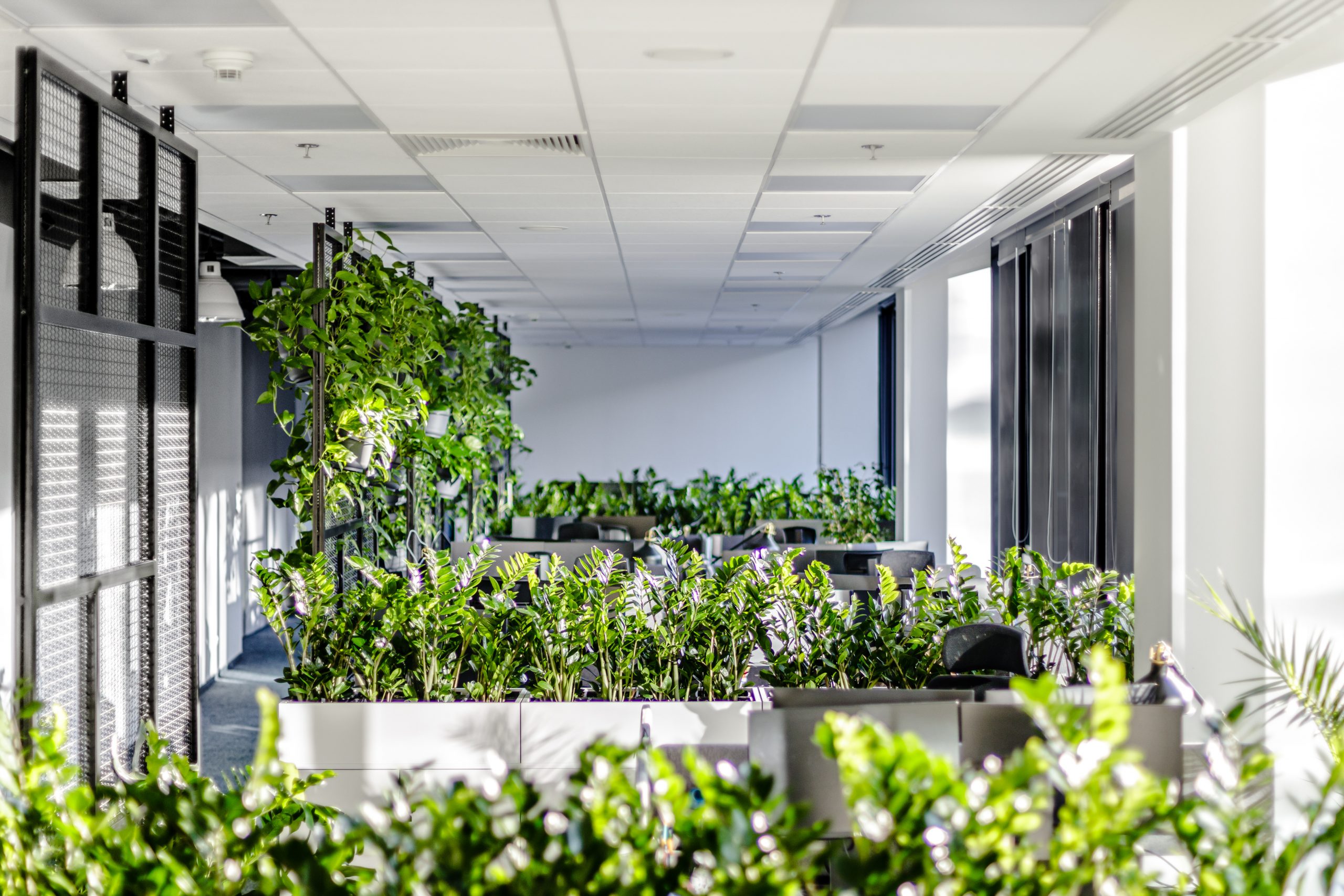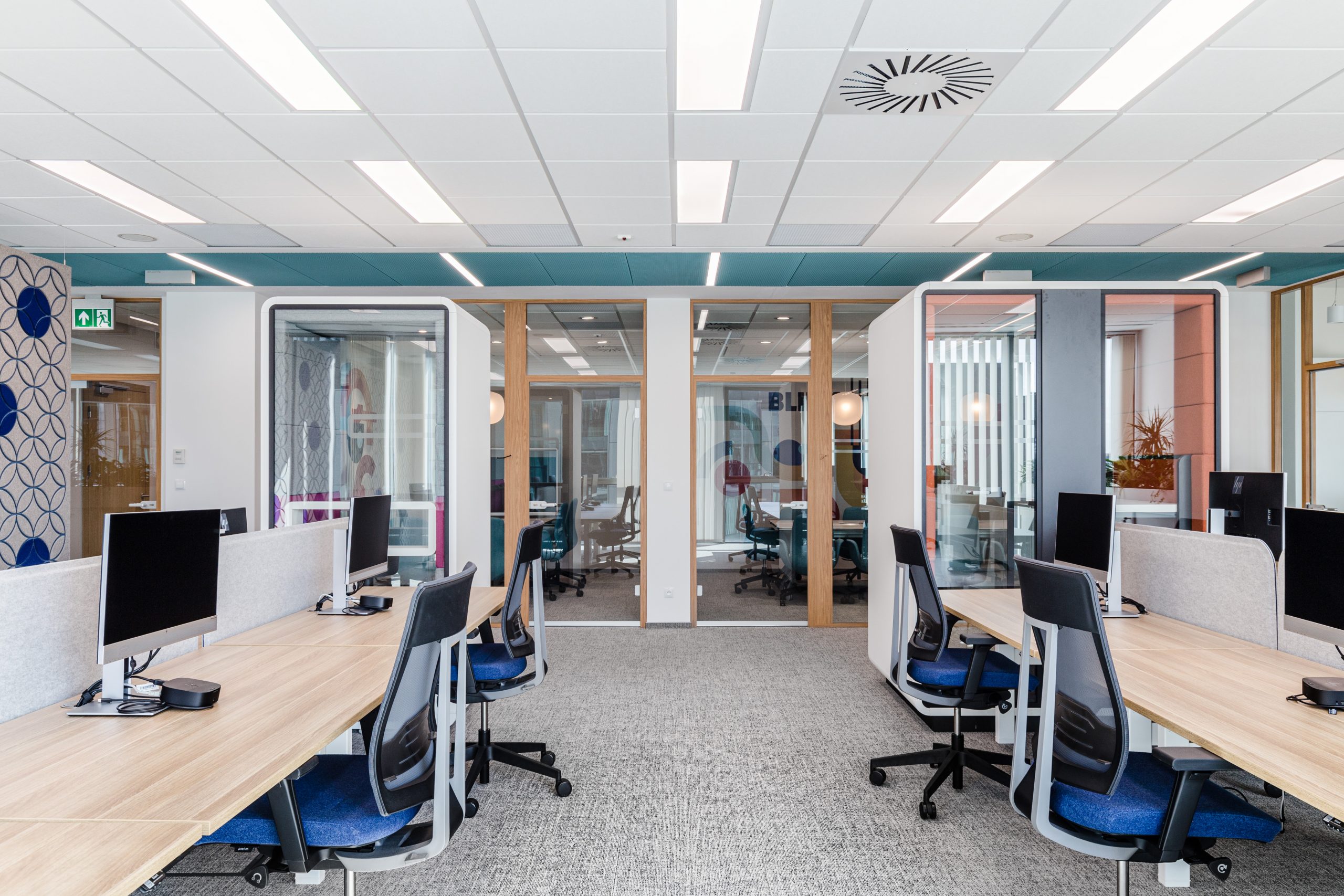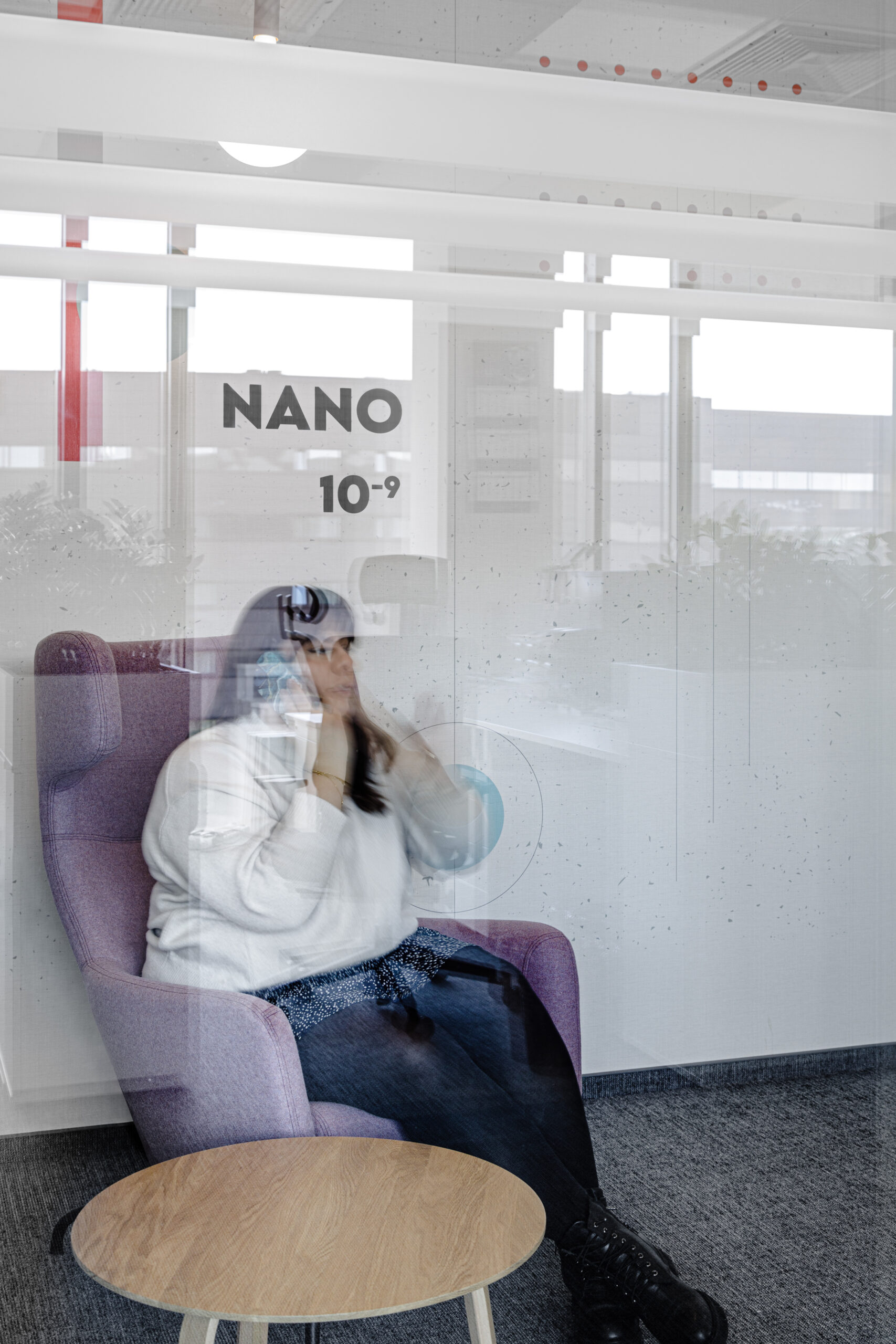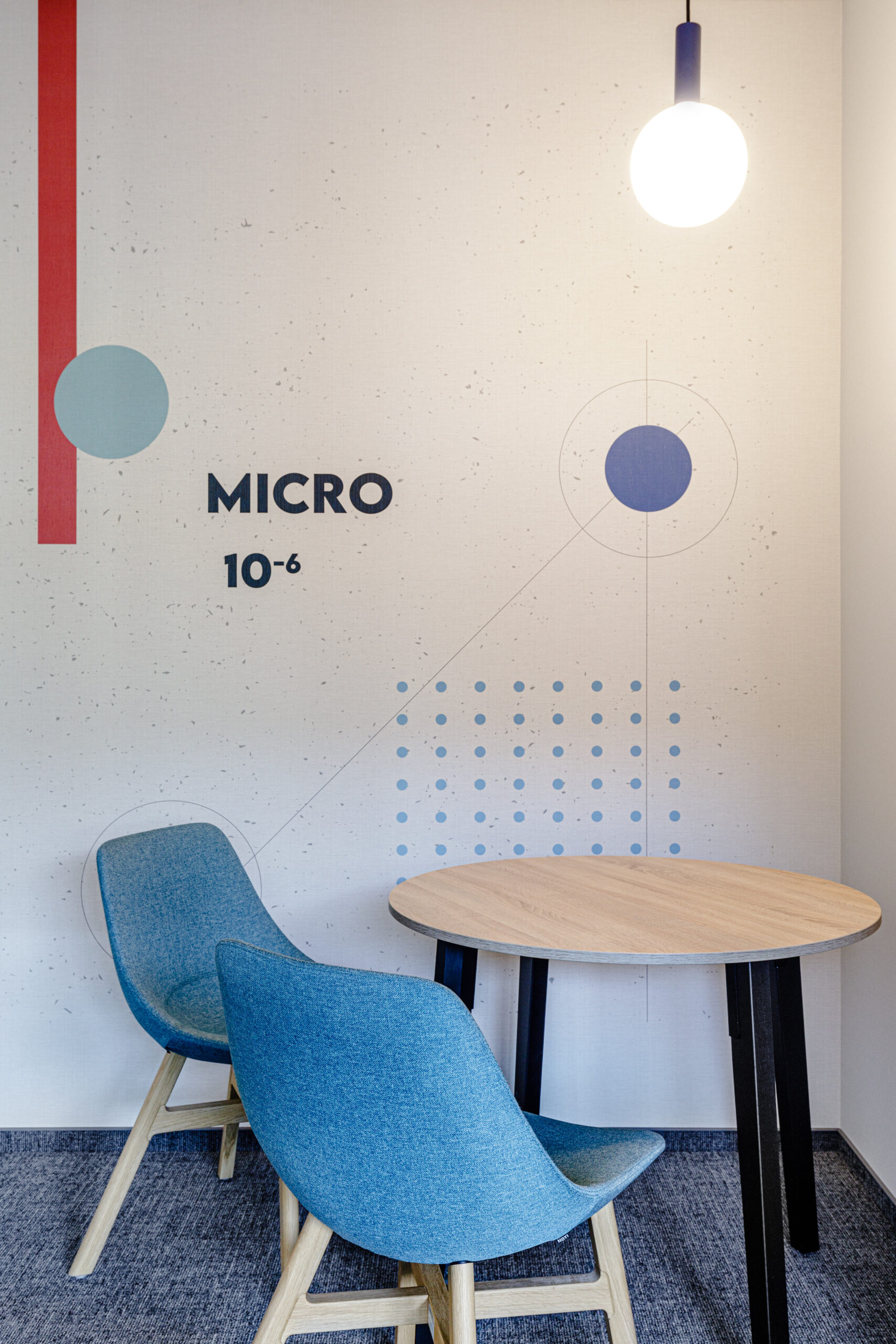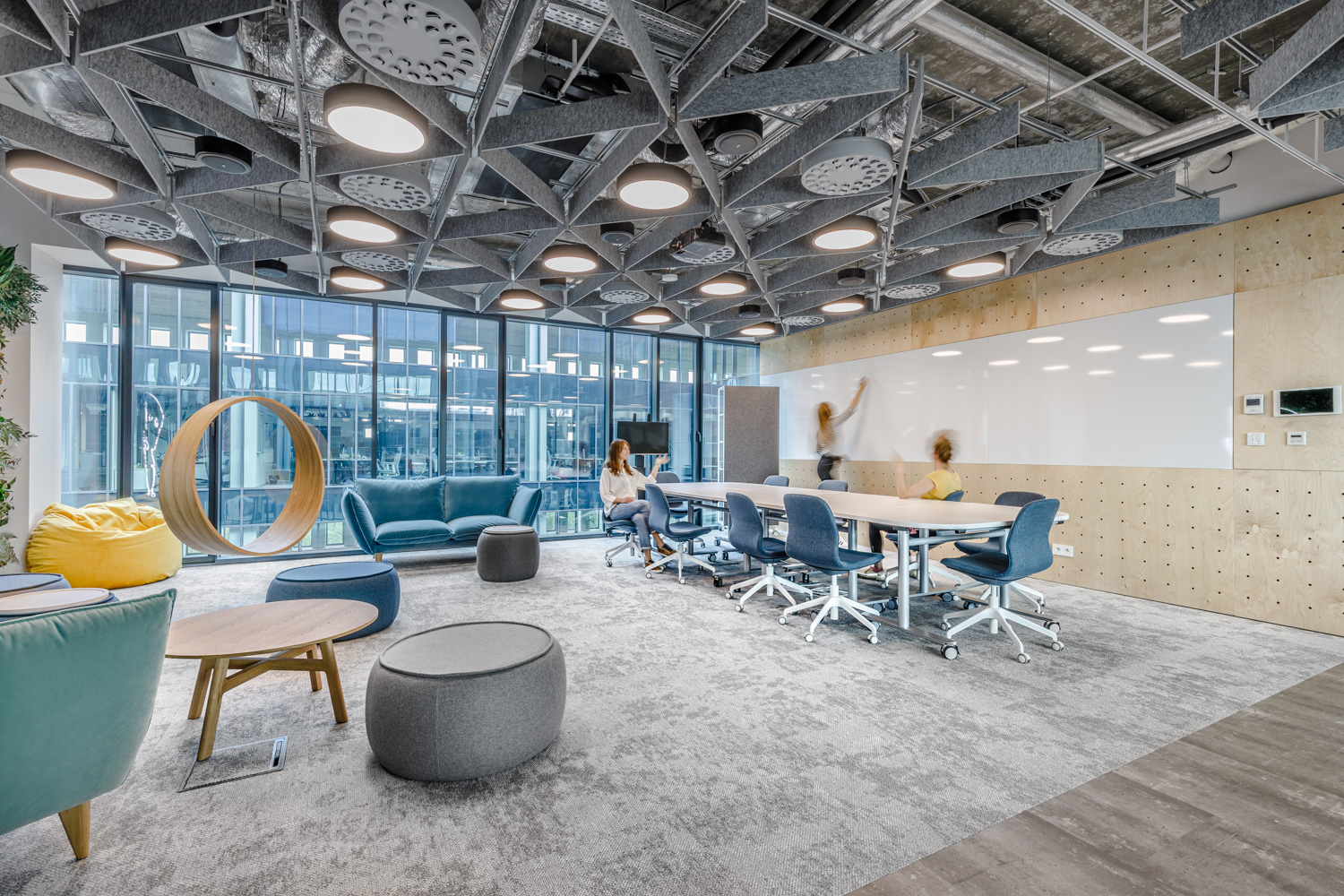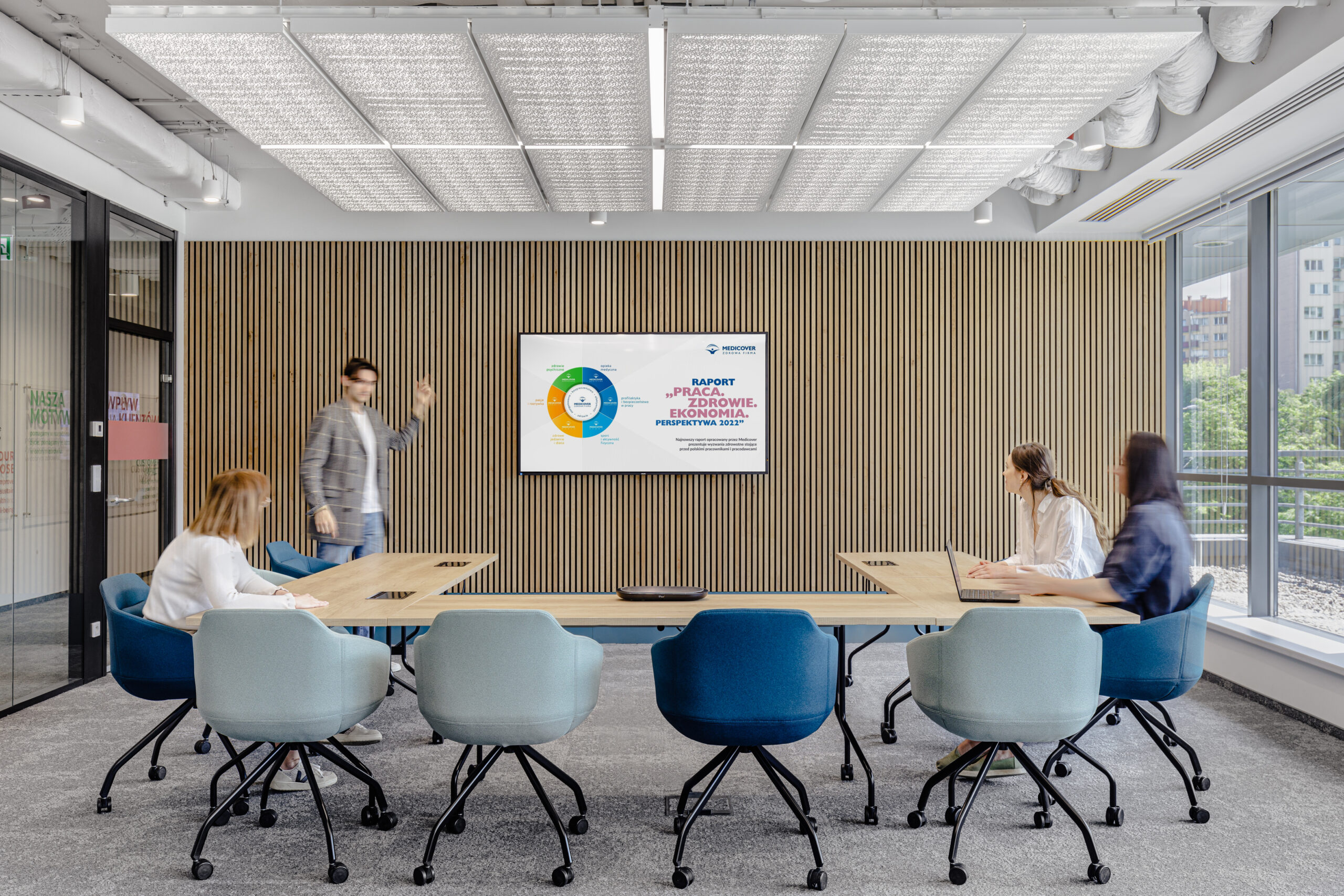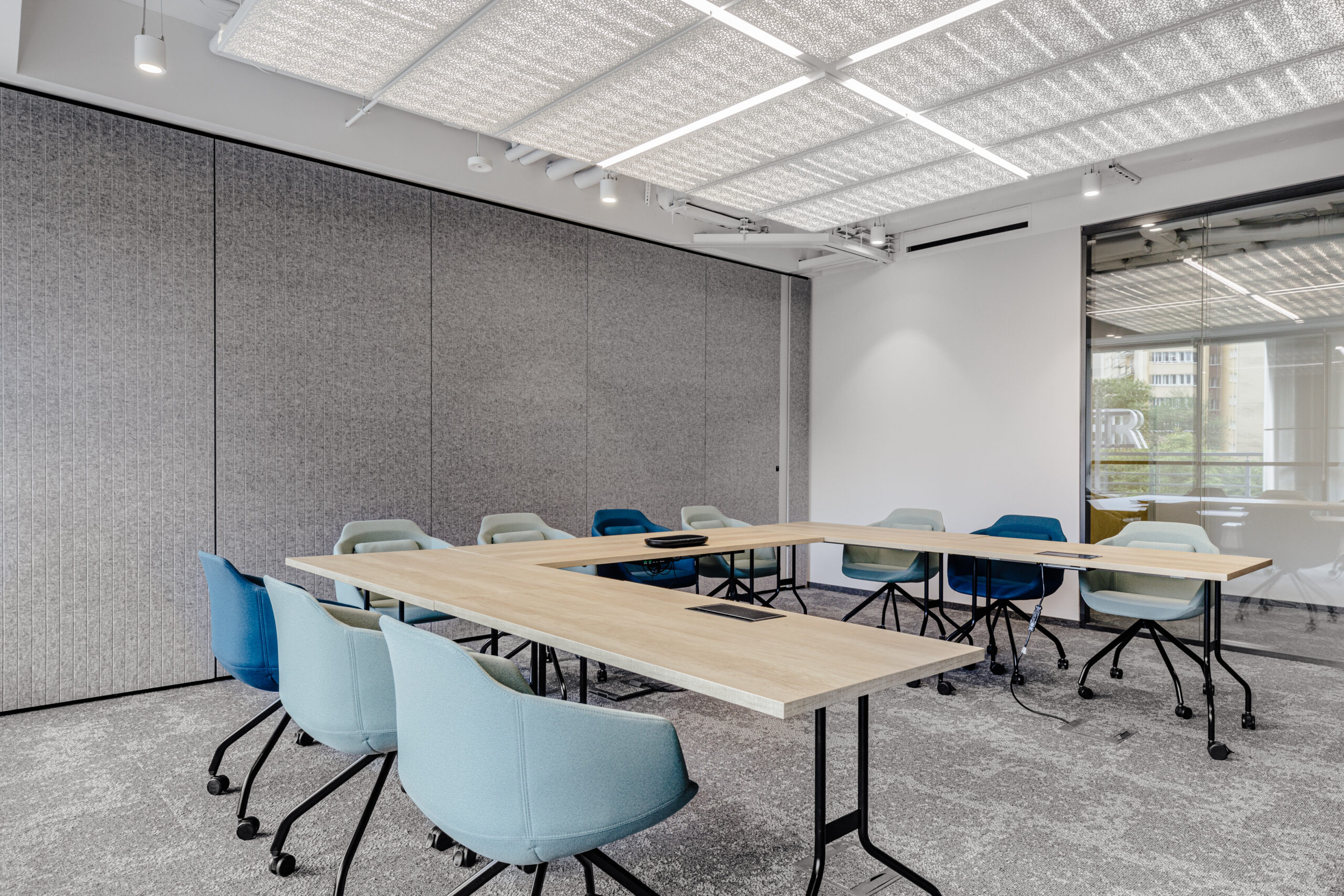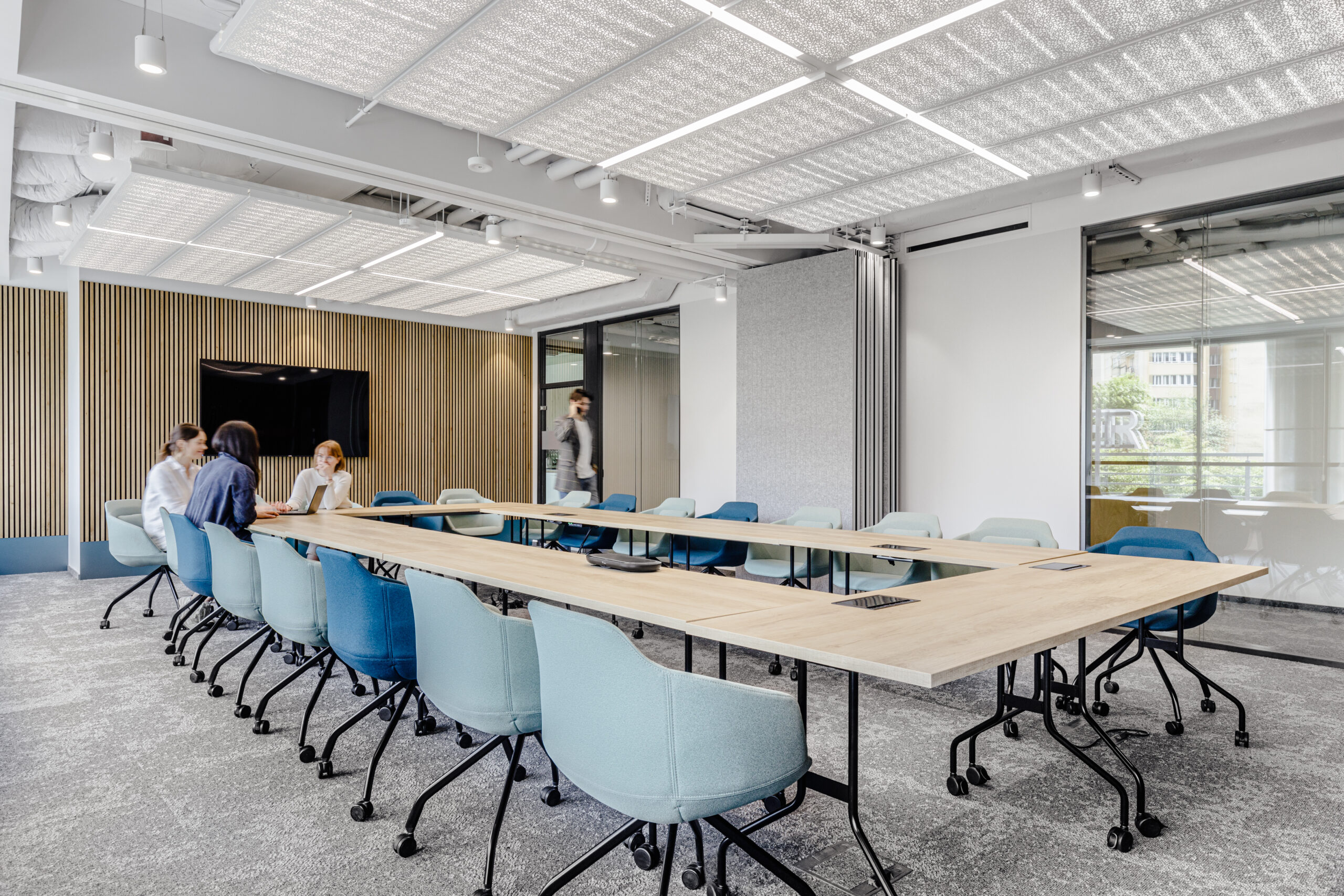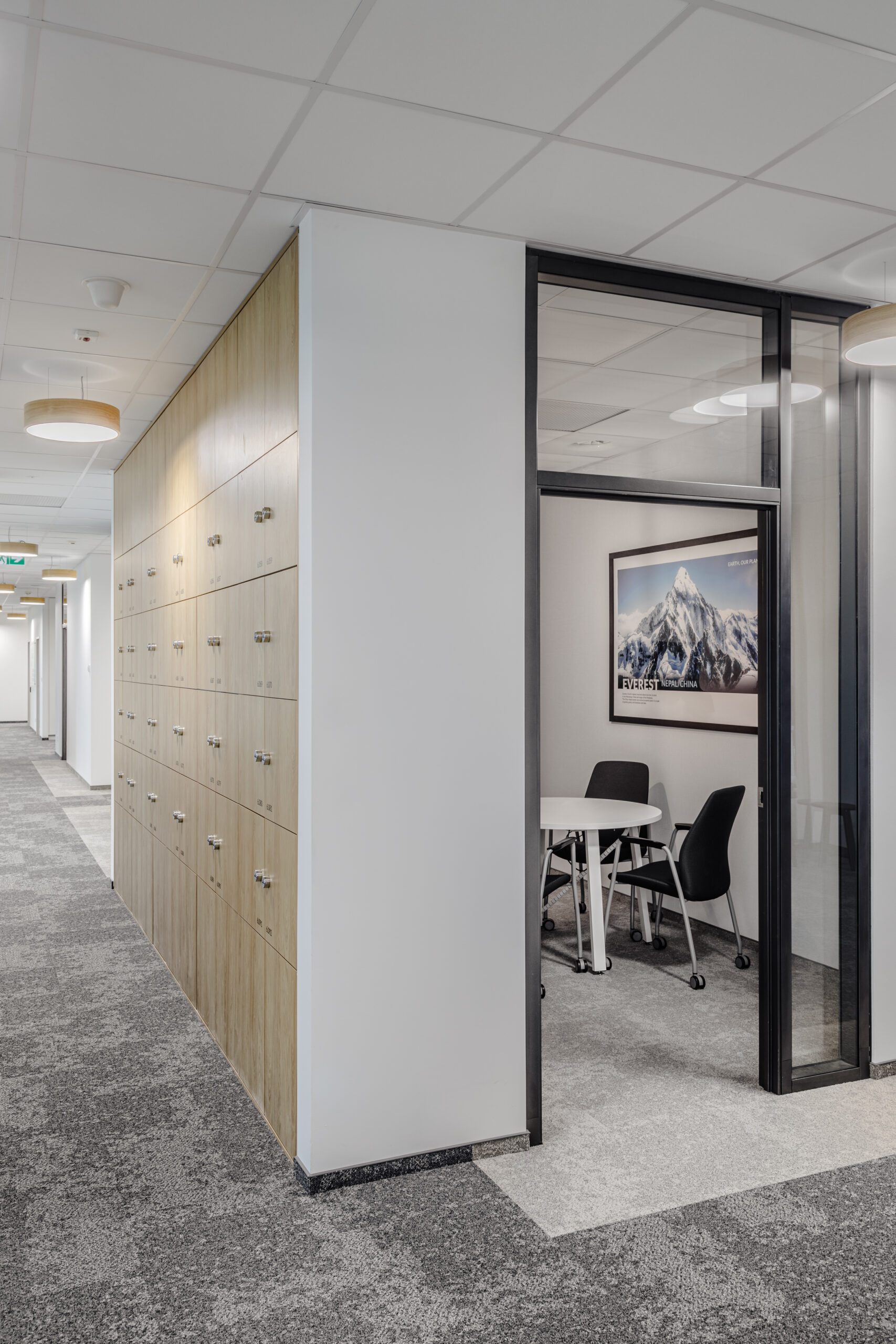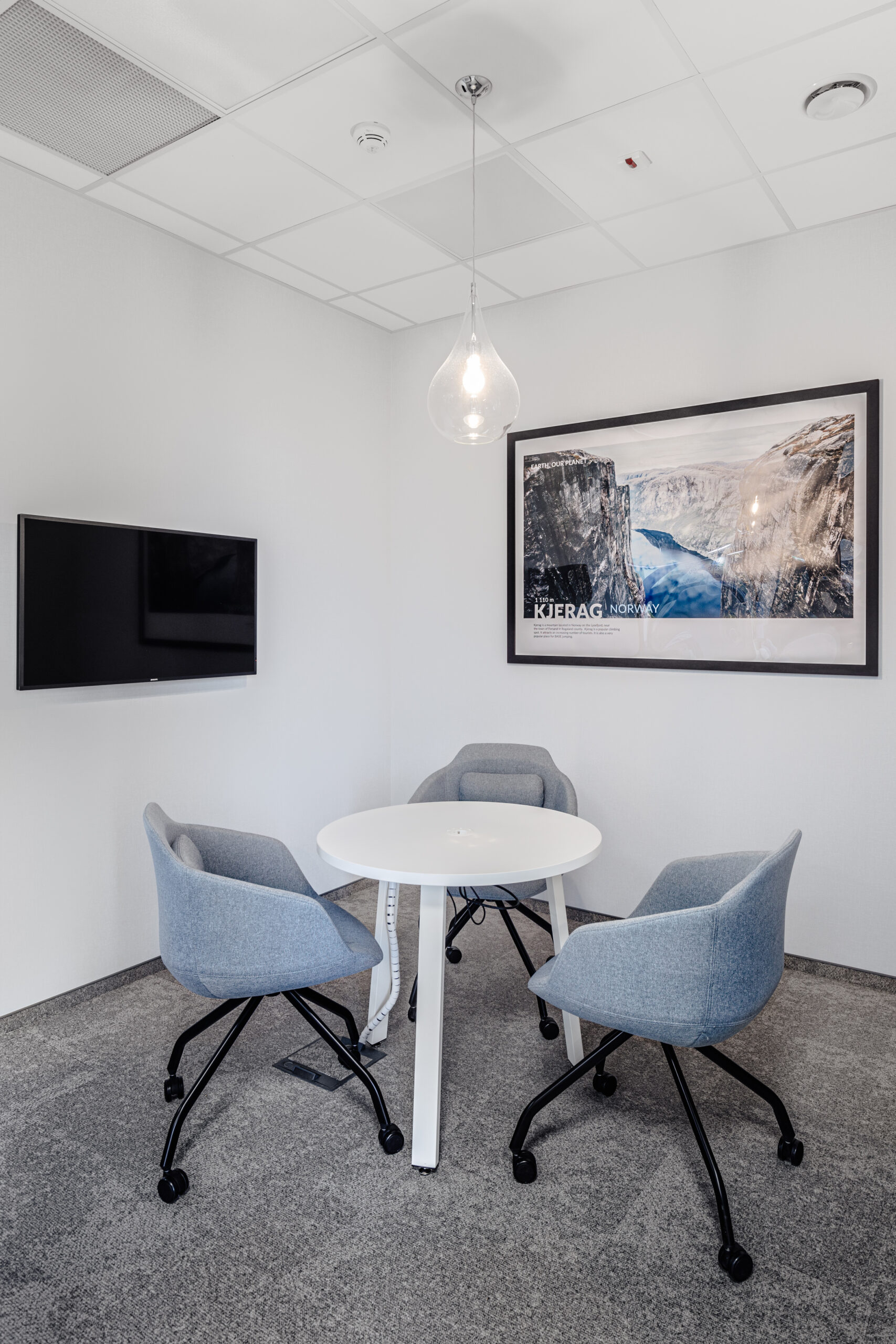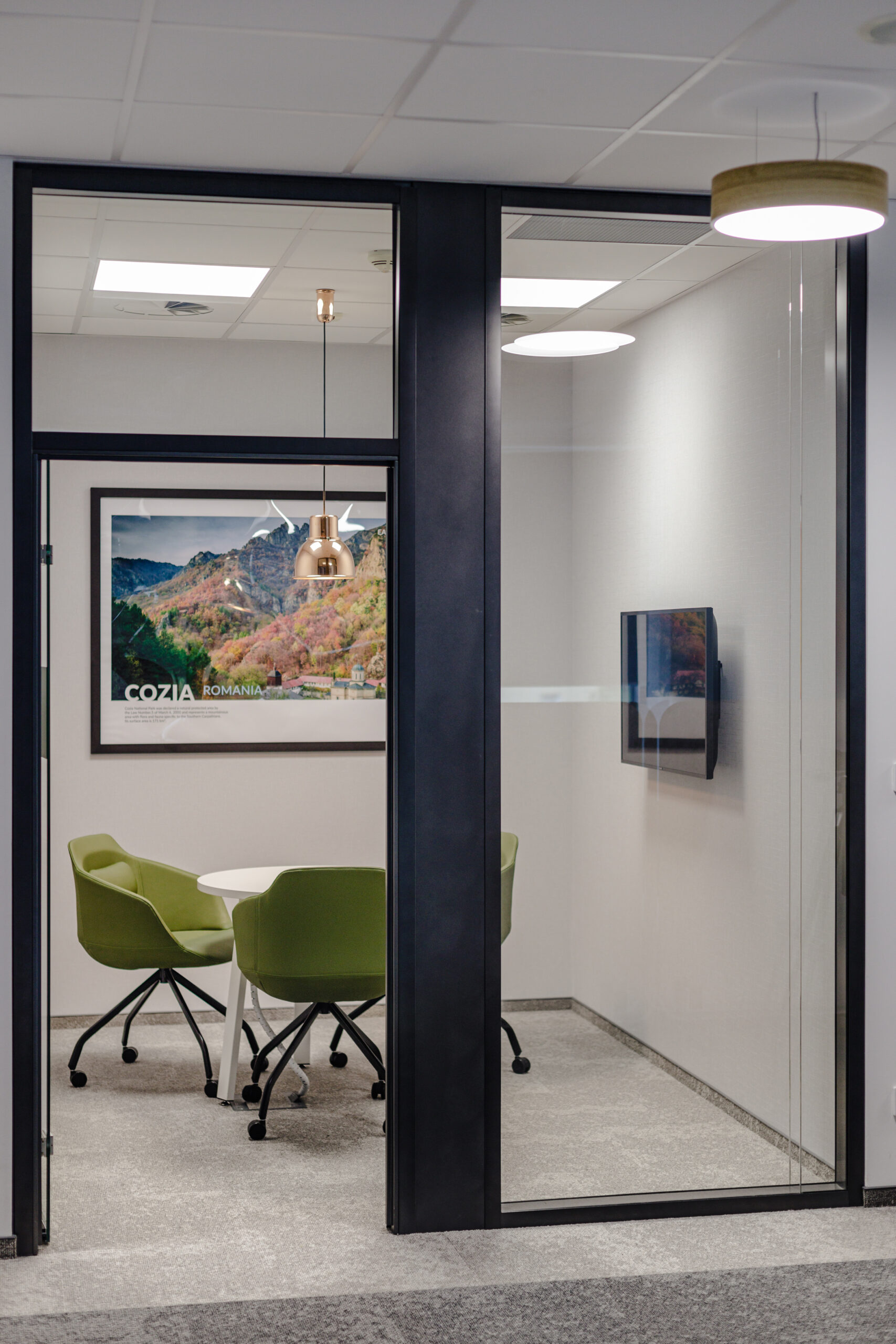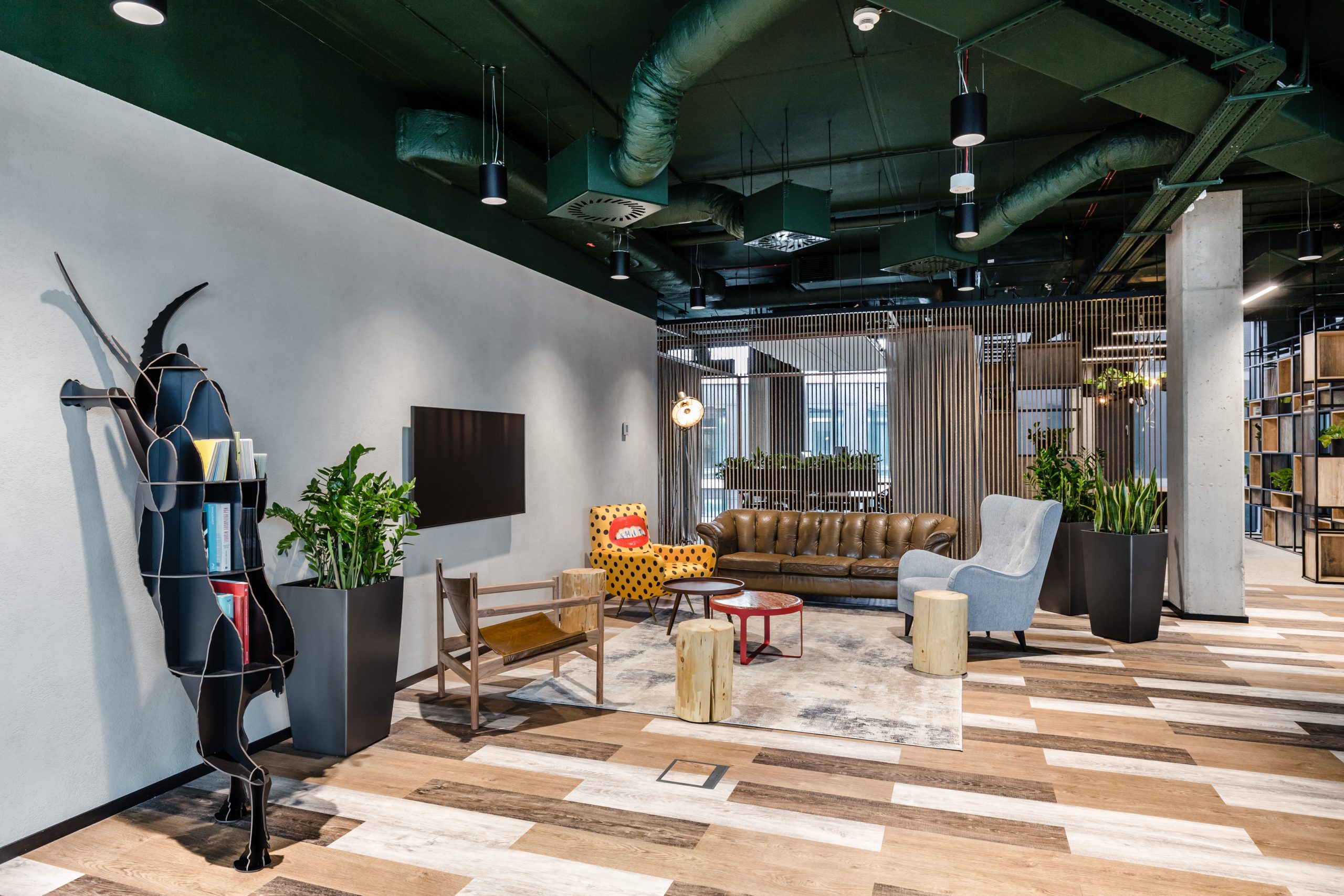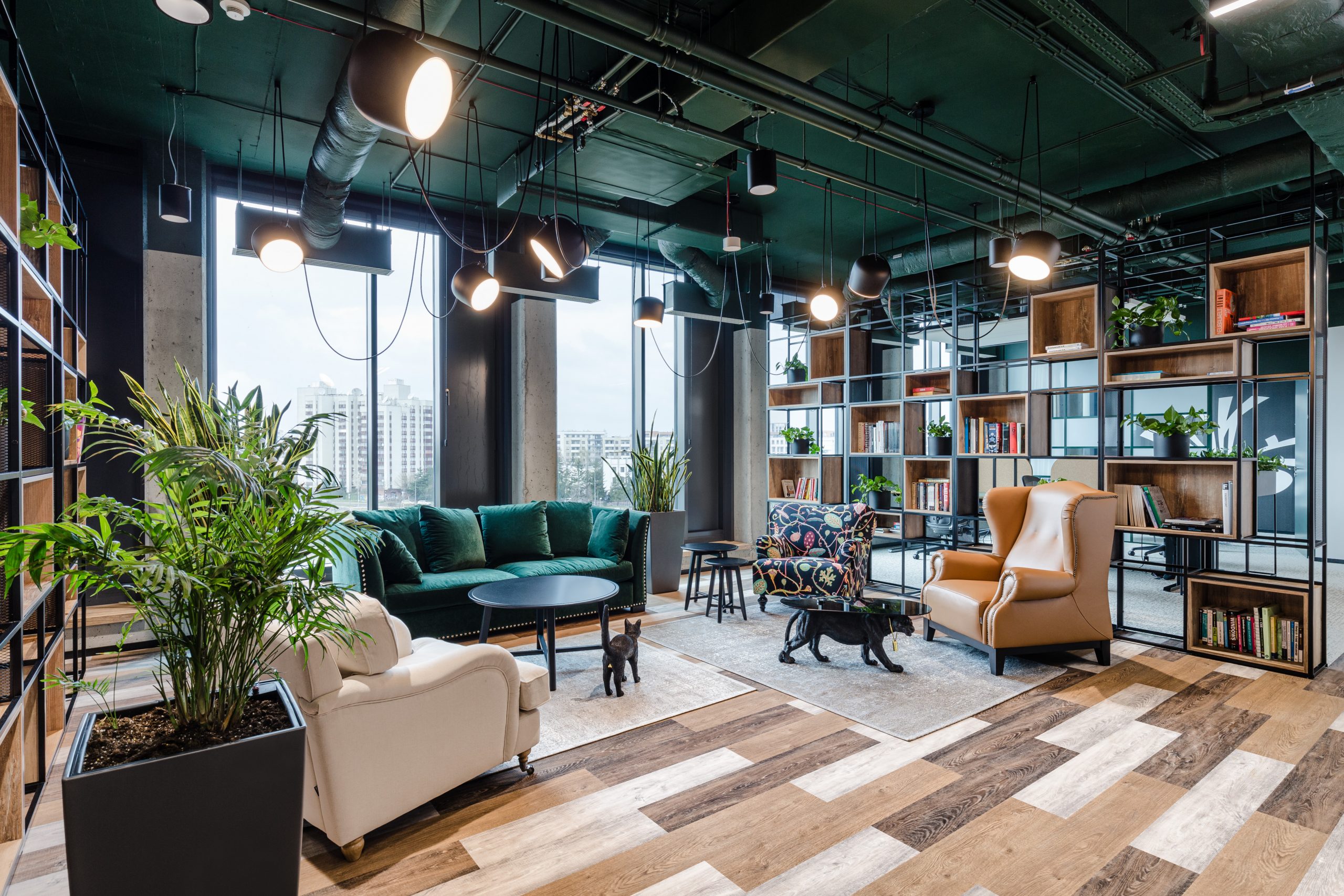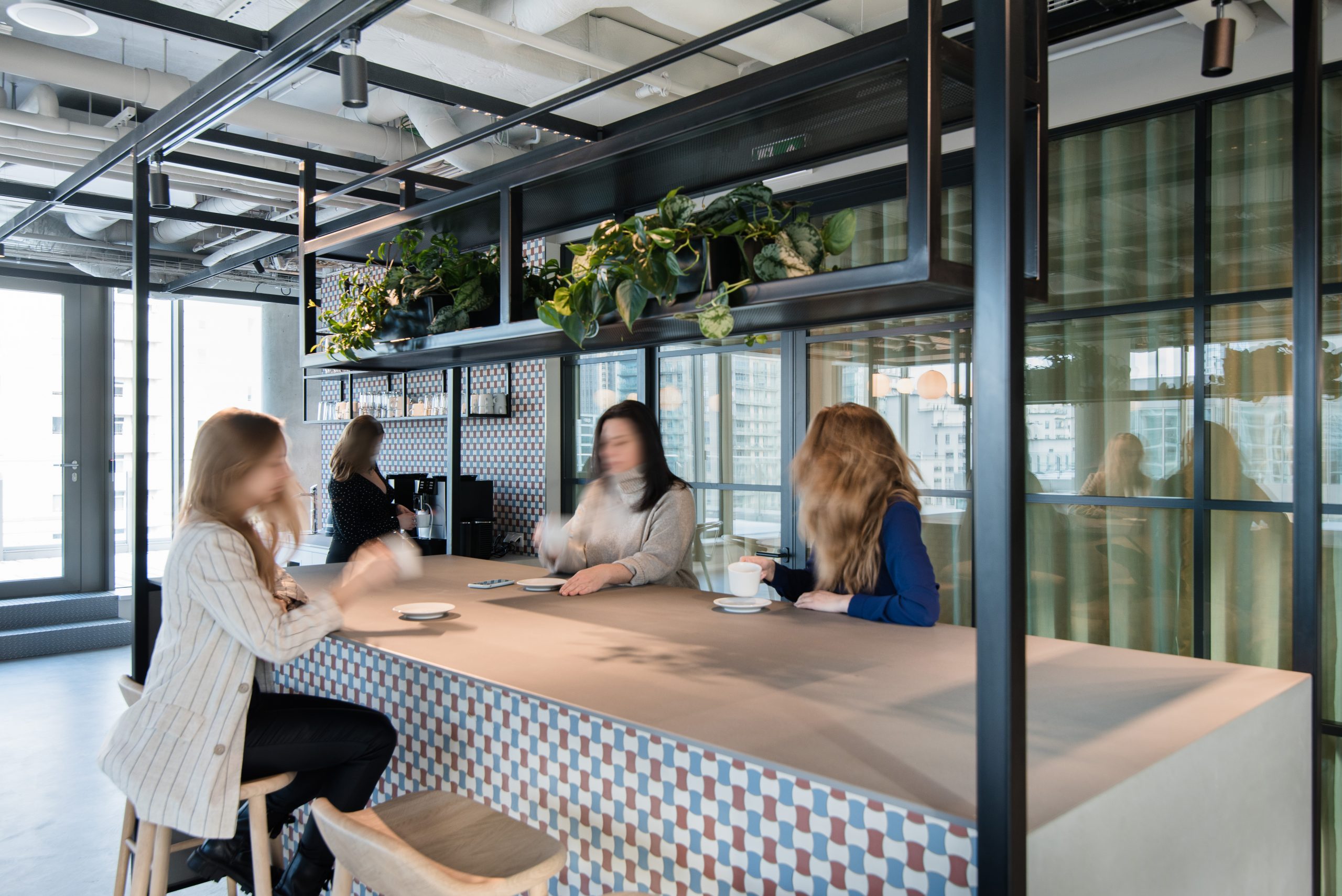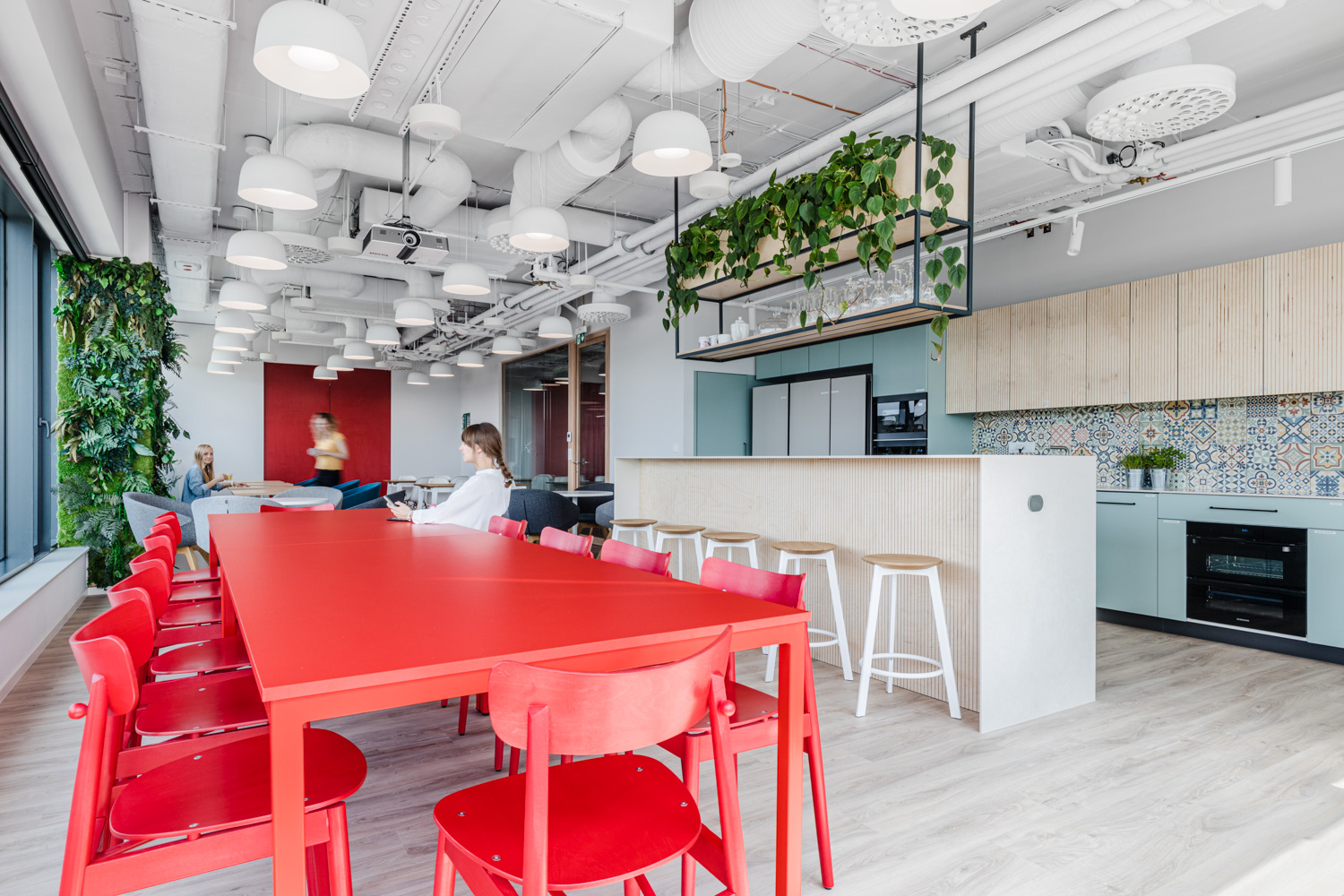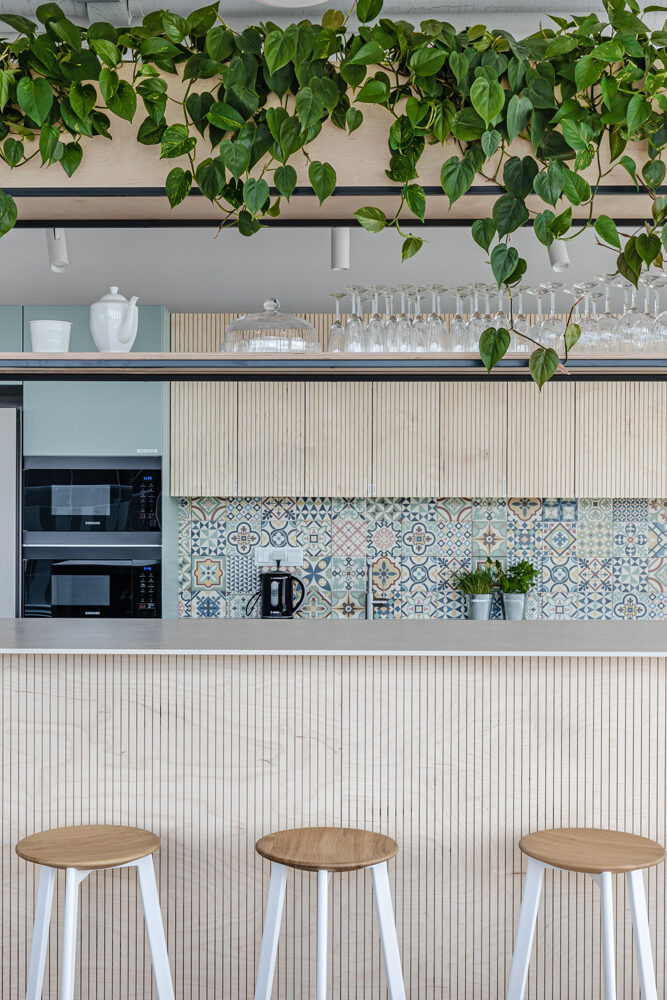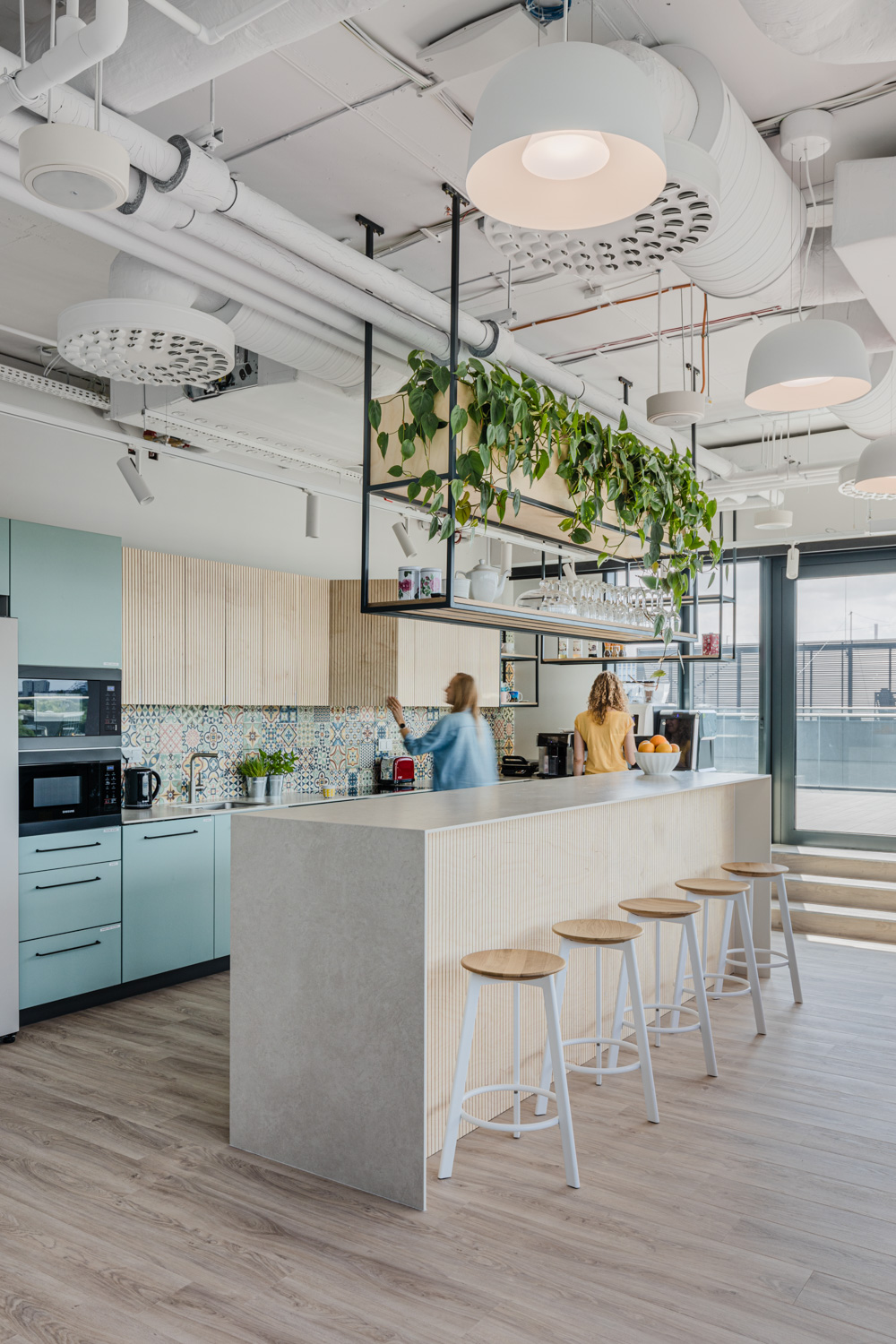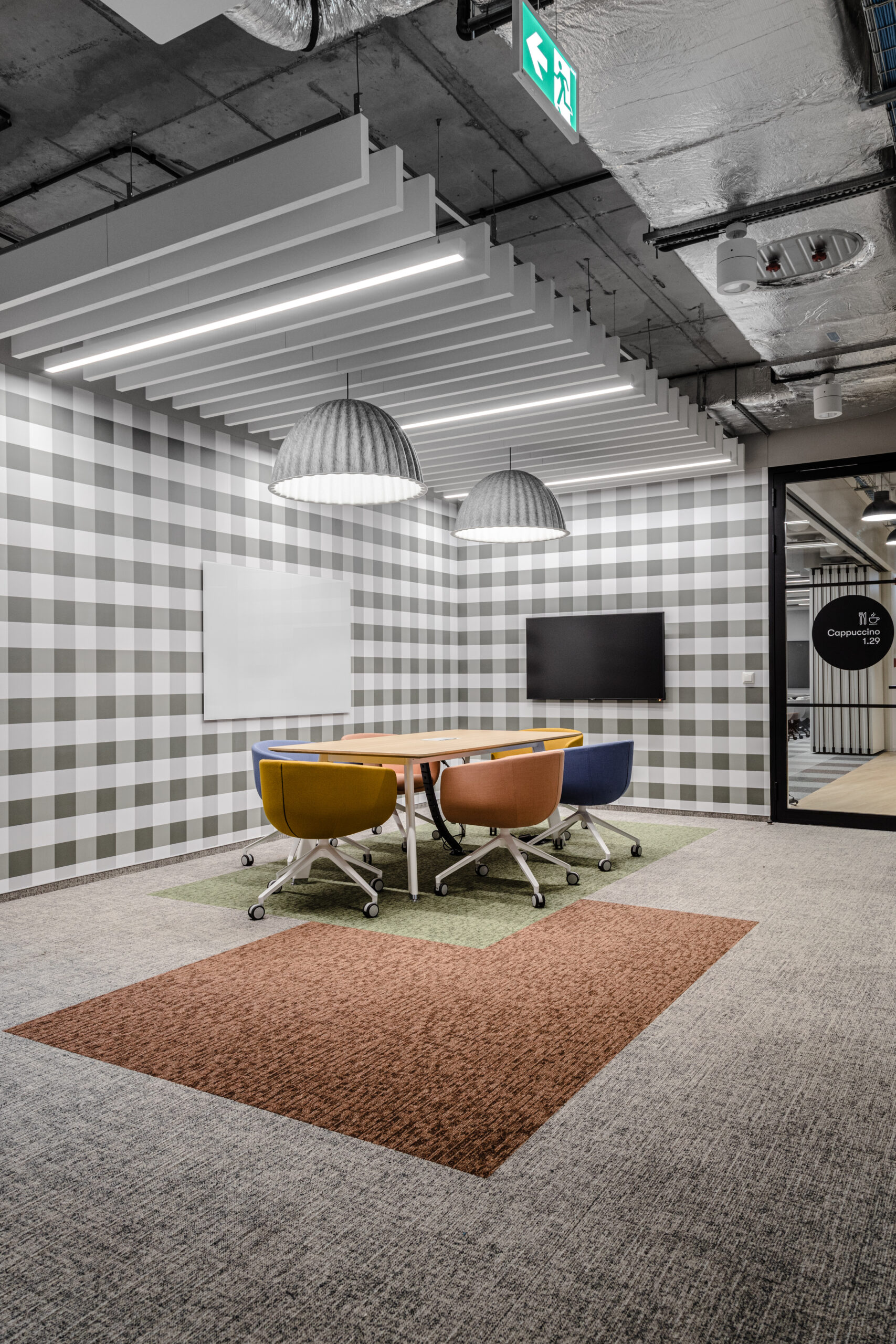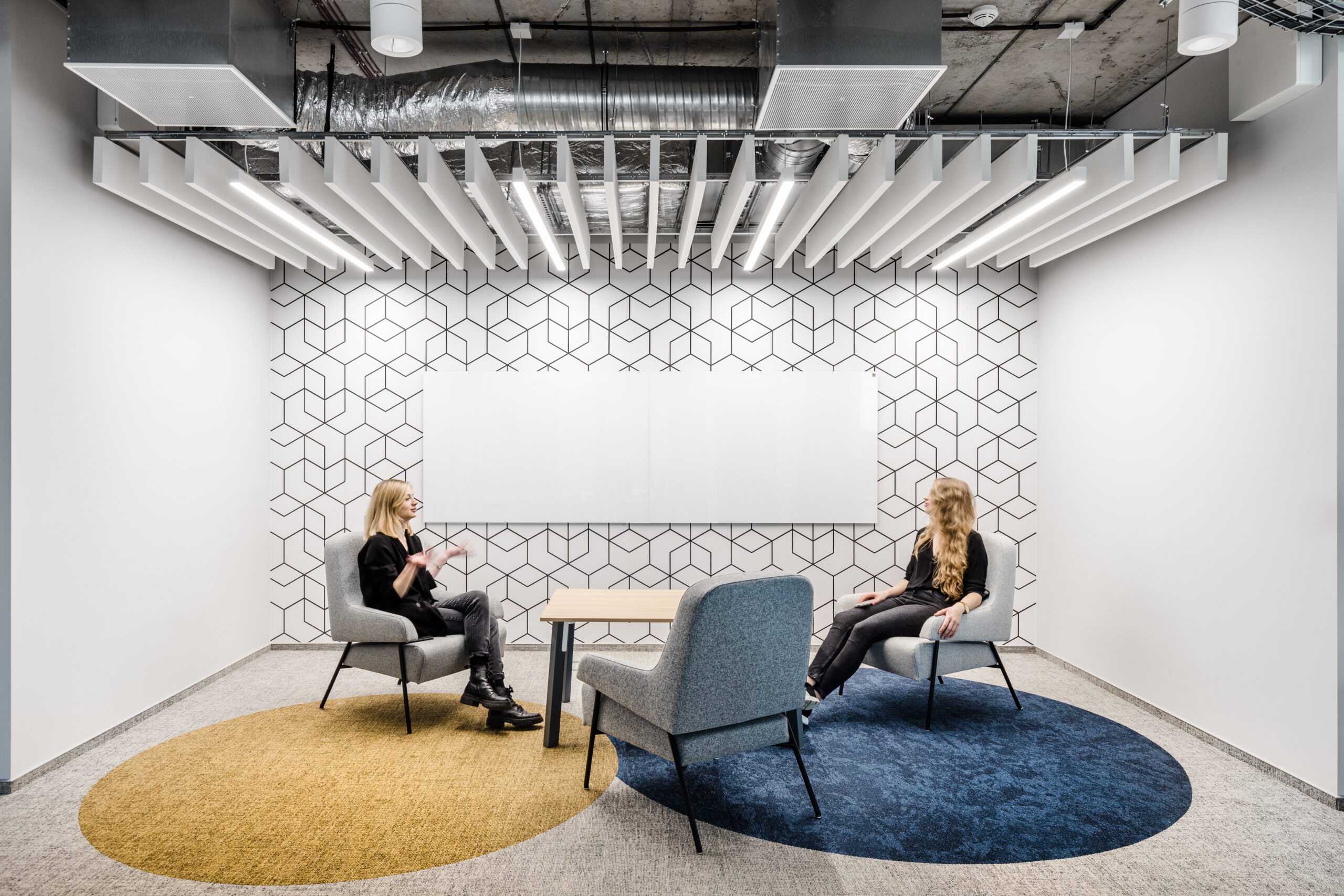9 types of office spaces that support hybrid work
Has office space gained or lost ground for employees and employers amid the hybrid work model? What impact does remote work have on offices? This article outlines how you can adapt your office to the hybrid model.
Hybrid work has transformed how we are utilizing office spaces. This does not mean, however, that the solutions previously used in offices have completely ceased to be functional. Shifts in the needs of employees and their work styles are driving us to use certain types of spaces available in our offices in a different way than in the past.
What do hybrid work models entail?
Since the proliferation of remote work, a growing number of organizations are allowing employees to do some of their work from home. However, this new model of work, known as hybrid, has many variations, and one should rather use the plural form – talking about hybrid models.
In some organizations, it is stipulated that employees will come to the office two or three times a week, and one of these days may be fixed for each team so that the people in that team can see each other in person at least once a week. Other organizations also allow for a hybrid work model implemented in the form of conventions held every month or every few weeks, during which employees are present in the office for a week to work remotely for the following weeks. Some companies have introduced several different work models to accommodate the needs of individual teams. The so-called hybrid model is thus a diverse set of solutions that shape how work is performed, and this diversity can be observed both between different companies and within particular organizations.
The introduction of hybrid models is associated with flexibility: the ability to choose not only where to do the work, but also how to organize it and decide which tasks can be carried out more efficiently at home and which ones at the office.
Hybrid work personas – what do employees need depending on their work style?
Work style is a set of activities we engage in and the amount of time we spend on those activities. Such a definition was adopted by consultants from Colliers, who analyzed the work styles of more than 3,000 people during the COVID-19 pandemic. The purpose of the analysis was to see if it was possible to distinguish key work styles – groups of people who work in similar ways, regardless of the type of work they do, their organization, or their job level.
The analysis made it possible to identify 3 main work styles described in the guide “Hybrid Work Personas“.

Diverse style
People representing this style of work carry out a wide variety of activities in the course of their typical day…People representing this style of work carry out a wide variety of activities in the course of their typical day, beginning with individual work, through meetings, to phone calls, and working with equipment and documents. Representatives of this work style can be found in all organizations and almost every team. This style of work is also characteristic of the majority of managers.

Focused style
People representing this style devote the vast majority of their day to individual work…People representing this style devote the vast majority of their day to individual work, including that which requires deep concentration. Any other activities occupy about 25% of their work time.

Caller style
People representing this work style spend almost all of their working time making phone calls…People representing this work style spend almost all of their working time making phone calls. Any other activities, including individual work or meetings and interactions, collectively take up about 16% of their working time. This style is most commonly encountered in call center-type organizations and teams.
The work styles described above can be found in many organizations. However, it is often the case that an organization has its own unique set of work styles.
The transition to a hybrid work model makes work styles function in unusual ways. Whenever there is a job done partly in the office and partly remotely, our work style is slightly different depending on where we are working on a given day. When working remotely, we are much more likely to engage in activities that require silence and focus, and those that do not require interaction with other people. In contrast, when we choose to come to the office, we tend to focus on collaboration and formal and informal interactions with others.
To learn more about what kind of person you can be, and the impact of hybrid models on individual work styles, read the guide.
9 types of office spaces that support hybrid work – which spaces provide the best support for each work style?
Nowadays, the key to a successful office space design is diversity. Each of the work styles described above has slightly different spatial needs due to the distinct sets of activities performed in the office. The ideal workspace is one where everyone can find something for themselves: a space for focused work, an area where you can have an informal meeting with your teammates, and a conference room for convenient video conferencing.
Many of the conventional types of spaces that can also be found in pre-pandemic office design will also work well in hybrid offices. Some of them should be properly adapted to the new work styles and the higher intensity of work that is mediated by synchronous communication tools. In the offices of organizations working in hybrid models, the importance of individual spaces and their share of the overall office space is also changing. What are these spaces, what has changed in them, and how?
1. Open space
The proliferation of hybrid work in organizations has caused office attendance to drop significantly. As a result, many companies have decided to reduce the number of desks and introduce shared workstations. The open plan office, which allows users to easily share workstations and does not impose rigid boundaries between the zones of individual teams, has thus become a solution that many organizations have opted for.
However, for an open space to work properly and not be associated with negative effects on work comfort, it must be designed properly. A key aspect is acoustics. To ensure acoustic comfort, an open space should not be designed as one large hall filled with desks. Modern open spaces consist of zones with up to 20-30 workstations, separated by additional spaces of various types – meeting rooms, informal areas, etc. Such a division improves the acoustic parameters of the office, and a sufficiently wide range of additional spaces makes it possible for employees who need to hold a meeting or make a phone call to use these spaces and not disturb their colleagues in the open space.
Examples of open space zones in the project for Emerson:
2. Phone booths for calls
Nowadays, an increasing number of calls are made using a computer rather than a cell phone, but it is impossible to eliminate phone calls. That is why in spaces occupied by individuals or teams whose work style largely consists of performing individual tasks in a focused manner, phone booths for conversations will work perfectly. Answering phone calls while sitting in an open space is distracting to everyone else working in that area, even if that conversation is in a hushed voice. If a phone booth is in sight, it provides an opportunity to answer a phone call, whether private or business, confidentially without disturbing others.
Phone booths are also, to a lesser extent, a solution for teams whose work consists of making phone calls, or for individuals who make many long phone calls. These people will prefer to make business calls in open spaces with improved acoustics or small rooms. However, phone booths can work well as a place to make private calls, which can always happen in an office.
Examples of phone booths in the project for Alcon:
3. Focus rooms — rooms for quiet work
In the era of hybrid work, the importance of focus rooms, or meeting rooms for up to two people, is growing rapidly. They are nowadays not only places for work in concentration, but also serve several other functions.
In teams and areas where the interaction between employees is frequent, a focus room will perform well as a place to support tasks such as reviewing a contract, checking a list of figures, or writing a long e-mail. For those in teams whose work style we would describe as focused, on the other hand, such a room will be useful as a place to conduct phone calls and video conferences in a non-disruptive manner for the rest of the co-workers.
In organizations that have created democratic open spaces without managerial offices, on the other hand, a focus room will provide good support for the day-to-day tasks of executives that require working in focus or participating in confidential video conferences.
A focus room should be designed bearing in mind the following guidelines:
- Good acoustic isolation – the person working in it must be able to concentrate on the task at hand, and if he or she is conducting a video conference, this should not disturb others, such as those sitting in the adjacent room.
- Absence of reverberation – if one or more of the walls is made of glass, some sound-absorbing material should also be used to balance it: it could be a special panel installed on the wall or a curtain made of thick fabric, also offering the possibility to separate oneself from visual stimuli or ensure the confidentiality of the content displayed on the monitor.
- Ergonomics – this is supposed to be a friendly and comfortable place, equipped with an ergonomic desk and chair.
- Access to daylight and a window view – people who participate in long conferences or have several meetings in a row in the focus room will be able to look into the distance, which is important for their eye work and overall comfort.
- Alternative light sources – if the room does not have access to daylight, it should have two sources of light: overhead light and a spotlight to illuminate the workstation.
- Ventilation – good access to air is the basis for employee well-being, and the amount of air in an office is one of the most important metrics in certifications that determine the quality of an indoor work environment.
Examples of focus rooms in the project for Emerson:
4. Creative zone
In modern organizations, the importance of projects carried out by different people from a particular department or within interdisciplinary working groups consisting of specialists from various teams is increasing. The creative work of such groups needs appropriate spatial support: friendly multifunctional and flexible rooms, which can be quickly rearranged by equipping them with, among other things, movable furniture.
To encourage collaboration properly, teamwork areas need to be properly designed for specific activities, such as displaying materials on a large screen, taking notes on ideas and drawing diagrams, and laying out materials and documents on tables. Any tools such as flip charts or dry-erase surfaces suitable for note-taking during brainstorming sessions are a significant part of this. Tables and chairs should move easily so that within one meeting you can arrange, for example, a classroom layout, which works well when one person is presenting something, and then set up tables and chairs so that you can collaborate comfortably in sub-groups.
Examples of a creative zone in the project for Prisjakt:
5. Conference rooms – AV-enabled for remote meetings
Before the pandemic period, the main problem with meeting rooms was their scarcity, with organizations complaining primarily about the insufficient availability of rooms for 2-4 people. Indeed, in many organizations, meetings of this size accounted for the majority of meetings held, which was rarely reflected in the number of appropriately sized rooms.
The proliferation of hybrid meetings, i.e. meetings in which some people participate remotely, has made the number of people physically present in meeting rooms even smaller. The provision of an adequate number of small meeting rooms has therefore become even more important.
At the same time, many hybrid teams are deciding to designate one day when all team members show up at the office together. On such days, there is an increasing demand for larger meeting spaces – both rooms and alternative solutions, such as areas enclosed by mobile walls that can be folded down if a very large meeting is to be held.
Also, one should not forget to properly equip larger, less formal meeting spaces that can be converted into temporary meeting rooms. After the pandemic period, it is essential to be able to hold hybrid meetings in such a way that the differences in the comfort of attending the meeting are minimized for those connecting remotely and those present in the office. Systems for holding teleconferences, equipped with a camera, microphones, and an appropriate sound system, are useful here. Some organizations also opt for interactive screens, which allow dispersed teams to work together on one whiteboard in real-time.
Examples of conference rooms in the project for Medicover:
6. Relaxation zone
Since we started working in a hybrid model and showing up at the office not five, but two-three days a week, our visits at the office have become more intentional. Having those 2-3 days to spend in one space with our co-workers, we want to make the most of that time – to talk face-to-face, hold a joint workshop and brainstorm, or at least have a coffee and a chat together. As a result, relaxation zones, arranged as informal zones, are becoming increasingly popular in offices. Zones where we can have a casual time with others – talk or hold an informal meeting. On the other hand, so-called game rooms are becoming less popular. This is because people working in a hybrid model rarely decide to undertake a trip to the office to devote their time to playing on a console.
.
Examples of a relaxation zone in the project for SYZYGY & Ars Thanea:
7. Networking — an area designed for social integration
In the wake of the pandemic, there is increasing talk about the role that the office should play in terms of facilitating integration and relationship building among members of hybrid teams. As a result, networking zones are becoming more common in offices. Two things are key when it comes to such zones.
First – the arrangement of the networking zone. In spaces of this type, an informal design works well, allowing for both a quick ad-hoc meeting, a 1-on-1 conversation, and a meeting involving a larger number of people – such as a company-wide town hall or a client conference. A desirable feature of this type of space is also flexibility – that is, the possibility of easy rearrangement.
Second – the location of the networking zone in the office space. For the zone to fulfill its function, it should be located in the heart of the office – at the intersection of the main communication paths. It is also a good idea to place it close to the office kitchen or coffee point. Even the best-designed networking zone will remain empty if using it requires walking to the other end of the office or going to another floor.
Examples of a networking zone in the project for SEB:
8. Kitchen and dining room
In the lists of office spaces that should be designed for a given organization, called functional programs, the kitchen and dining room have generally been listed in the social spaces section – as opposed to places where work is done. In practice, in many organizations, this distinction between social and work performance spaces is fading. For hybrid work teams, the office becomes a place to catch up on daily communication and build relationships. Kitchens and dining rooms are being used as areas for team meetings and integration, where current projects are discussed over food in a less formal atmosphere. They are also becoming places where larger company-wide meetings are held, both informal and formal such as quarterly summaries.
At the same time, health consciousness is on the rise, and there is a greater concern today for employee wellbeing, which includes eating regularly and peacefully, in a relaxed atmosphere and with team members. This also means that the importance of kitchens and dining areas is increasing, and organizations are willing to dedicate more space to them and incorporate custom designs.
Examples of a kitchen and dining zone in the project for Prisjakt:
9. Agile zones
Agile work models, commonly used in the IT industry, are taking organizations by storm. This is not so much the result of fashion, but a response to the volatility, complexity, and unpredictability of present-day reality. Agile, iterative ways of management are better suited for managing projects that involve people from different teams and require a lot of creativity. Agile goes hand in hand with innovation.
Agile zones are spaces that are tailored to the nature of agile methods, are open and supportive of both communication and individual work, and provide opportunities for flexible change. They should offer the possibility to conveniently organize a stand-up coordination meeting (popular in the Scrum methodology), visual access to the team’s notes or task list (displayed on a screen or flipcharts), the ability to organize a workshop session or consultations in smaller groups using dry-erase surfaces.
Examples of a agile zones in the project for Amway:
The hybrid work model, and office space
The pandemic has changed how we work for good, accelerating the evolution of office spaces. However, changes in working styles do not necessarily entail a complete redesign of offices. Adapting spaces to the realities of hybrid work, nonetheless, requires an understanding of employees’ current needs and a thorough assessment of the extent to which our work environment meets the requirements of hybrid teams. This is especially important for those organizations that are concerned with ensuring that employees perceive the office as a place worth returning to.
Schedule a half-hour consultation with our work environment consultants and architects to learn more about the needs of your work model.

